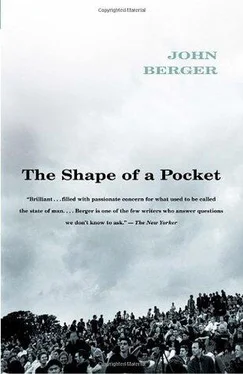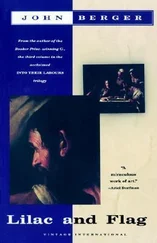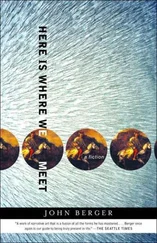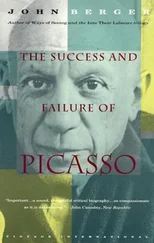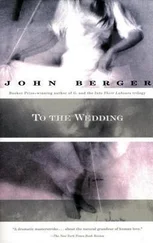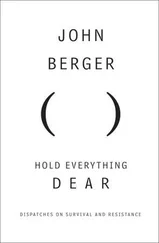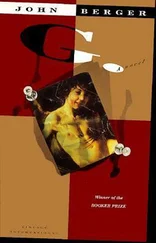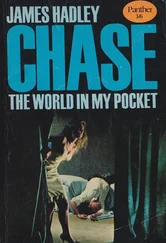An old story that goes back to the caves.
Place , place in the sense of lieu, luogo, ort, mestopolojenie. The last Russian word also means situation and this is worth remembering.
A place is more than an area. A place surrounds something. A place is the extension of a presence or the consequence of an action. A place is the opposite of empty space. A place is where an event has taken or is taking place.
The painter is continually trying to discover, to stumble upon, the place which will contain and surround his present act of painting. Ideally there should be as many places as there are paintings. The trouble is that a painting often fails to become a place. When it fails to become a place, a painting remains a representation or a decoration — a furnishing.
How does a painting become a place? It’s no good the painter looking for the place in nature — it wasn’t in Delft that Vermeer found it! Nor can he search for it in art — because, despite the belief of certain post-modernists, references don’t make a place. When a place is found it is found somewhere on the frontier between nature and art. It is like a hollow in the sand within which the frontier has been wiped out. The place of the painting begins in this hollow. Begins with a practice, with something being done by the hands, and the hands then seeking the approval of the eye, until the whole body is involved in the hollow. Then there’s a chance of it becoming a place. A slim chance.
Two examples. In Manet’s Olympia the hollow, the place (which of course has nothing to do with the boudoir in which the woman is lying), began in the folds of the bedcover by her left foot.
In a drawing by you of a mango and a knife — they are black and about life-size on a sheet of yellowish paper on to which dust has blown — the place began when you laid the fruit in the curve of the knife’s blade. The paper became its own place at that moment.
* * *
The Renaissance notion of perspective, with its predilection for an outside viewpoint, hid, for many people during several centuries, the reality of painting-as-place. Instead, a painting was said to represent the ‘view’ of a place. Yet this was only theory. In practice the painters themselves knew better. Tintoretto, great late master of perspective, turned the theory on its head, time and again.
In his Carrying of the Body of St Mark the painting as place has nothing to do with the perspective of the immense piazza with its arcades and marble paving stones, and everything to do with the haphazard pile of logs in the middle distance on which the saint was going to be cremated. From the brush strokes of those painted branches of wood everything else on the canvas stems — the fleeing figures, the camel’s coat of hair, the lightning in the sky, the saint’s foreshortened limbs … Or, to put it another way, it is from the wood pile that the web of the whole colossal painting was spun.
And since Jacopo Robusti pursues both of us as Tintoretto, here is another example. In his London Susannah and the Elders the painting-as-place did not begin with her incomparable body, or with the artful mirror, or with the water coming up to her knee, no, it began in the strange artificial flowering hedge which she is facing and behind which the Elders hide. When Jacopo, with a full brush, began touching the hedge’s flowers, he was arranging the place to which everything else had to come. The hedge took over as host and master.
Working alone, the painter knows that far from being able to control the painting from the outside, he has to inhabit it and find shelter in it. He works by touch in the dark.
In your studio the light, towards evening, changes, and the canvases change more than anything else which can be seen. (Far more than the crumpled paper with the two words.) Exactly what changes in them? It is hard to say. Their temperature perhaps and their air pressure. For they do not change in this light like paintings. Each changes like a familiar terrain outside a door. Like places.
How does a painter work in the dark? He has to submit. Often he has to turn around in circles instead of advancing. He prays for collaboration from somewhere else. (In your case from the wind, the termites, the desert sand.) He builds a shelter from which to make forays so as to discover the lie of the land. And all this he does with pigment, brush strokes, rags, a knife, his fingers. The process is highly tactile. Yet what he is hoping to touch is not normally tangible. This is the only real mystery. This is why some — like you — become painters.
When a painting becomes a place, there is a chance that the face of what the painter is looking for will show itself there. The longed-for ‘return look’ can never come directly to him, it can only come through a place.
If the face does come, it is partly pigment, coloured dirt: partly drawn forms always being corrected: but, most importantly, it is the becoming, the coming-towards-being of what he was searching for. And this becoming is not yet — and, in fact, never will be — tangible, just as the bison on the walls of the canvas were never edible.
What any true painting touches is an absence — an absence of which, without the painting, we might be unaware. And that would be our loss.
The painter’s continual search is for a place to welcome the absent. If he finds a place, he arranges it and prays for the face of the absent to appear.
As you know, the face of the absent can be the backside of a mule! There are no hierarchies, thank God.
Has something been saved? you ask.
This time, yes.
What?
A part, Miquel, of what begins again and again.
You, Marisa, who have painted so many creatures and turned over many stones and crouched for hours looking, perhaps you will follow me.
Today I went to the street market in a suburb south of Paris. You can buy everything there from boots to sea urchins. There’s a woman who sells the best paprika I know. There’s a fishmonger who shouts out to me whenever he has an unusual fish that he finds beautiful, because he thinks I may buy it in order to draw it. There’s a lean man with a beard who sells honey and wine. Recently he has taken to writing poetry, and he hands out photocopies of his poems to his regular clients, looking even more surprised than they do.
One of the poems he handed me this morning went like this:
Mais qui piqua ce triangle dans ma tête?
Ce triangle ne du clair de lune
me traversa sans me toucher
avec des bruits de libellule
en pleine nuit dans le rocher.
Who put this triangle in my head?
This triangle born of moonlight
went through me without touching me
making the noise of a dragonfly
deep in the rock at night.
After I read it, I wanted to talk to you about the first painted animals. What I want to say is obvious, something which everybody who has looked at Palaeolithic cave paintings must feel, but which is never (or seldom) said clearly. Maybe the difficulty is one of vocabulary; maybe we have to find new references.
The beginnings of art are being continually pushed back in time. Sculpted rocks just discovered at Kununurra in Australia may date back seventy-five thousands years. The paintings of horses, rhinoceros, ibex, mammoths, lions, bears, bison, panthers, reindeer, aurochs, and an owl, found in 1994 in the Chauvet Cave in the French Ardèche, are probably fifteen thousand years older than those found in the Lascaux caves! The time separating us from these artists is at least twelve times longer than the time separating us from the pre-Socratic philosophers.
Читать дальше
